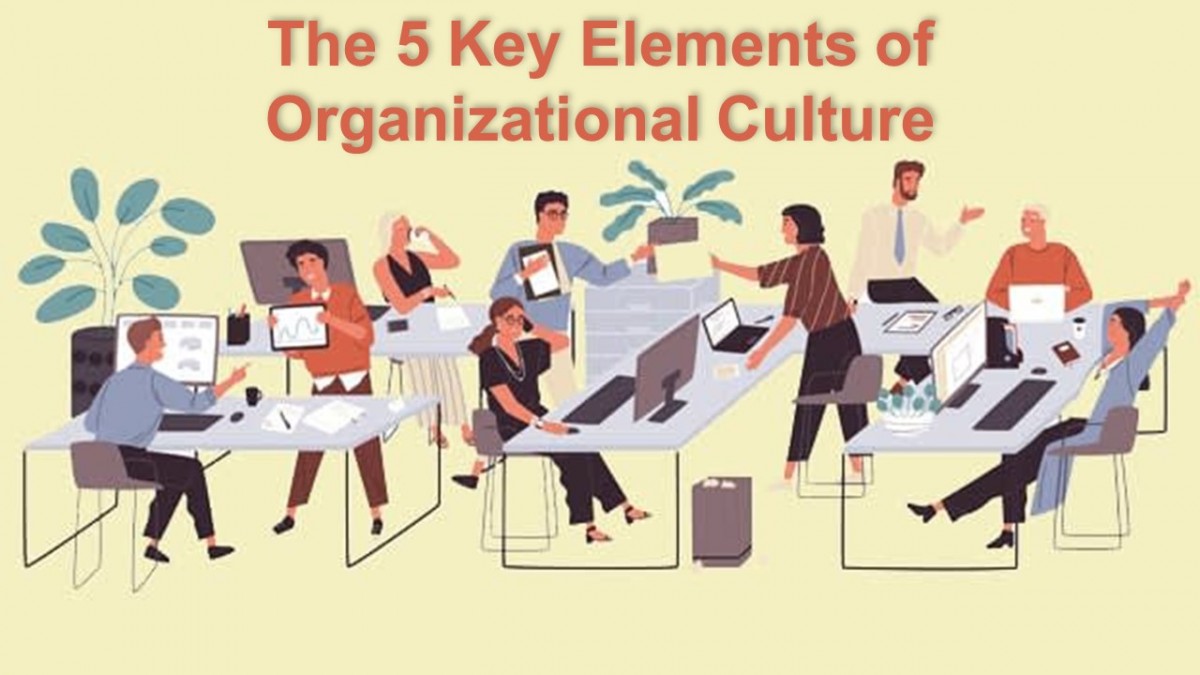Share:
Mark S. Babbitt, Contributor
S. Chris Edmonds, Contributor

As business leaders struggle with the impact of The Great Resignation and start to look inward at what might be next for their company culture, many are finally moving past the blame game.
Specifically, instead of blaming the economy, the government, and what they perceive as the fickle whims of employees, they are asking themselves:
Why is this company unable to keep and attract talent?
And for many organizations, this is the multi-million dollar question. So how do leaders—especially old-school leaders who believe throwing money at problems is the easiest solution—find the answer? They must ask this deeper-dive question:
What is it about our company culture that repels good people?
To help answer that question, we’ll examine the five key elements of uncompromising company cultures.
The five key elements of organizational culture are equally valuing respect and results, living a servant purpose, continuously focusing on trust, validation and growth, effectively and diligently measuring human behaviors, and using your voice as a leader for the greater good.
After taking a deep-dive into these elements, perhaps you, as a business leader, will take a moment to reflect on how many of these characteristics your company can say you’ve already mastered.
First, though, let’s define “uncompromising.”
Uncompromising Culture: One Definition
In Good Comes First: How Today’s Leaders Build an Uncompromising Company Culture That Doesn’t Suck, we state that leaders build a company culture upon the desired behaviors rewarded—and that leaders tear down culture by tolerating disrespectful behaviors.
With that in mind, let’s look at one definition of an uncompromising culture:
A steadfast refusal to tolerate undesirable or unproductive behaviors, either from a performance or values standard, that erode trust, positivity, or productivity.
Put another way: Results-focused leaders tolerate disrespectful workplace behaviors. By definition, that means they compromise their company’s work culture.
One Example: Bob in Sales
“Bob” is the top salesperson in his company. That company’s leaders count on Bob to perform well every quarter; he’ll exceed quota. However, along the way, Bob demeans other salespeople and makes sexist (and sometimes even racist) remarks to the support team.
Of course, as is typical of a workplace bully, he discounts any concerns his remarks generate. He defends his actions with “just kidding.” Still, his alpha male approach to work consistently makes others feel uncomfortable.
Bob’s sales manager and the Vice President of Sales are well aware of Bob’s disrespectful tendencies. They know he is the root cause of a psychologically unsafe workplace. And yet, they “can’t afford” to lose Bob. If Bob were to take his talents to the competition, the company’s short-term revenues would suffer. So Bob is allowed to keep being bad-Bob.
Eventually, his leaders ask Bob to serve as a mentor and role model to other would-be alpha males on the sales floor—he might even get promoted to sales manager. So junior sales professionals naturally adopt Bob’s professional style.
And why wouldn’t they? After all, Bob’s bosses don’t just tolerate Bob’s less-than-respectful approach; they consistently reward Bob for being the top salesperson. He even won a two-week, all-expenses-paid cruise to the Caribbean!
As workplace history shows us, adulation and emulation of someone like Bob are, far too often, natural occurrences. Knowing this is the quickest way to financial rewards and professional recognition, people with a similar mindset will follow in Bob’s footsteps. And in the meantime, many in the organization feel not just disrespected but, in some cases, dehumanized.
The result? By tolerating Bob’s uncorrected behaviors, this team’s leaders chose to compromise their company culture.
Sure, the sales manager and VP of Sales keep Bob (and people like Bob). But everyone else—good people—eventually leave. All because performance (results) was more important to the team’s leaders than creating a safe workplace (respect).
Company Culture: The 5 Key Elements
Within that backstory, and while using our working definition of uncompromising, let’s now take that look at the elements that uncompromising company cultures have in common.
Equally Valuing Respect and Results
In Good Comes First, “Equally Value Respect and Results” is the overarching operational strategy for culture leaders. And, after reading Bob’s story, the reason should be apparent.
Still, why do we place such emphasis on respect?
Well, because most workplaces suck. Additionally, in our work, workplace respect has repeatedly proven to be the primary indicator of a quality company culture. When leaders focus just as much on respect as they do results, we will find an uncompromising—purposeful, positive, and productive—company culture.
But don’t just take our word for it; consider the findings from two comprehensive studies by MIT:
- September 2021: MIT Sloan Management Review found that workplace respect is the most crucial factor in a positive employee experience.
- January 2022: MIT Sloan also determined that toxic company cultures are 10.4 times more likely to contribute to attrition than compensation.
Living a Servant Purpose
What is a “servant purpose?”
Your organization’s servant purpose is what your company does, for whom, and to what end. A servant purpose describes how or what your company does and how it improves the quality of life for employees, customers, and the communities served.
Essentially, your servant purpose is your reason for being—other than making a profit.
That higher purpose shifts your organization’s primary focus from making money (or making truck bumpers, circuit boards, or sandwiches—none of which are innately inspiring) to generating tangible benefits for your customers and your community.
When a leader lives their servant purpose, they don’t just serve the purpose—they also serve their people. And by doing so in a selfless fashion, they serve both the cause and the well-being of the people driving that cause.
Soon, the entire leadership team is focused on not just results, but on making people’s lives better.
A Deliberate Focus on Trust, Validation, and Growth
This culture element demands that leaders provide every player with the chance to work where trust is contagious, validation is pervasive, and growth is constant.
When trust is lacking, the best way to rebuild that trust is to demonstrate genuine care for others as they do meaningful work. And in the workplace, how do leaders best show an appropriate level of unmistakable care?
They do this by validating the good work of others, every day, and by recognizing and rewarding not just outstanding one-off performances but also the daily grind—the work that keeps the lights on. As a result, we become champions of not just our employees’ productivity, but their potential.
To help them live that potential, we also provide avenues for personal and professional growth at every opportunity. We certainly help our employees get better at what they do in the office.
But we must also support the entire person, not just the part that shows up to work every day. We help them grow as people, parents, sons and daughters, baseball coaches, homeschool teachers, den mothers, volunteers, members of our community, and mentors.
After all, we know good people, fully engaged in life and work, do good work.
Diligent Measurement of Human Behaviors
Human behaviors, good and bad, impact respect AND results.
Every organization knows how to measure results. But because we must equally value respect and results, leaders must also know their respect metrics. This means leaders must create a list of their company’s dominant values and behaviors, but this doesn’t need to be complicated.
Many of our clients, for example, generate a list of three to five desired values. They then determine three or four observable, tangible, measurable behaviors for each value.
For example, a value might be “integrity.” And a behavior that would indicate whether a leader was living the integrity value might be “I keep my promises” or “I do what I say I will do.”
Each leader (and soon each team member) promises to model the values and behaviors in every interaction, every day. We then measure each leader’s ability to meet that commitment, typically through confidential surveys completed by peers and direct reports.
Each question on the survey addresses a specific value and behavior. For example, each survey respondent rates their leader from 1 (strongly disagree) to 6 (strongly agree) on a question similar to “John keeps his promises.”
In this way, measuring respect becomes as commonplace as measuring results. And every company can now measure, as well as model, coach, and either celebrate or mentor,the impact their leader’s behaviors have on company culture.
Leaders Who Use Their Voices for Good
Perhaps the most surprising indicator of uncompromising company cultures: The presence of leaders who work hard to improve the lives of others while they live a servant purpose.
At one point in time, even in the recent past, it was okay for an organization—no matter what was happening in the world around it—to go “full ostrich.” When trouble came,when society’s issues knocked on the front door of the company’s headquarters, many leaders hid their corporate heads in the sand.
This ambivalence is not acceptable today. Employees and customers want to know what a company stands for—and what it won’t stand for. And they want to follow leaders who use their influence to make the workplace better while also making the world a better place.
So, to build a company culture that attracts and retains top talent, leaders must contribute to the well-being of employees, customers, candidates, and the communities they serve.
How Many Cultures Are Present at Your Company Now?
At this point, you may be asking yourself:
How many of these key culture elements can my company say we’ve already mastered?
The answer may, at first, be disappointing. But here’s why you, as a business leader, can’t retreat from this conversation:
In a typical work culture, there are too many Bobs. And there are too many leaders who have, for far too long, tolerated Bob’s unproductive behaviors.
Here’s the right-now reality for many leaders: You’ve always been measured, compensated, and promoted based on results. So the impact of the Bobs in the world of work was an acceptable casualty.
To achieve optimum results, we as leaders rationalized; we had to have a few Bob-types on the payroll—and maybe even in the C-Suite and boardroom. Besides, if we send all the Bobs packing, we won’t meet our right-now commitments or keep our coming-too-quickly promises.
And in the short-term, we get it. Again, the world measures leaders by this-quarter results.
But look around you. Do you really believe the so-called labor shortage has impacted every company the same?
It hasn’t. After all, people aren’t choosing not to work; mortgage payments and college tuition didn’t just disappear during the pandemic. Instead, they are choosing not to work unfulfilling jobs for lousy bosses within a company culture that sucks.
And where are they going?
The best talent is leaving for organizations whose values better align with theirs. And as we come out of our pandemic-dominated world, they seek out companies with company cultures that focus on results and respect.
Getting There: The Tactical and Practical Nature of Culture Change
The reality is that it took a long time for your company culture to form. So it may take a while for your culture to change. So while you can anticipate getting some quick wins once respect becomes as important as results, anticipate spending 12-18 months on culture reinvention.
Right about now, though, another reality might be in your face…
As a leader, you’ve never been asked to change company culture. You don’t know how. After all, your predecessor didn’t know either. Neither did your professors in business school. And that mentor you can usually rely on for been-there-done-that advice can’t help—because they haven’t been there and haven’t done that.
So please accept our best advice for launching a culture change effort, and break up the process into four bite-size pieces:
- Discovery | Invest the necessary time to learn more about your current culture. Go beyond what you think you know to learn: What is working well? What is not? What attracts good people? What drives good people away?
- Define | Along with your fellow leaders and critical employees, determine your uncompromising work culture by formalizing your servant purpose, defining your core values in behavioral terms, and clearly stating your strategies and goals.
- Align | Deliberately align your company’s daily work habits—from hiring practices to choosing new leaders—to the defined culture by modeling, coaching, measuring, and celebrating aligned players and practices.
- Refine | Consistently refine your work culture by mentoring players who keep proving they are reluctant to align with the defined culture; when necessary, invite people who are unable or unwilling to align with value and performance expectations to succeed somewhere else.
Take this approach, celebrate every little win along the way, and soon you’ll lead a company culture that will make you and your employees proud. But, perhaps even more importantly, you’ll stop worrying about the ongoing impact of The Great Resignation.
Because you’ll run a company where good people do good work.
And your competition will have all the Bobs.

Mark S. Babbitt is President of WorqIQ, a firm that helps organizations understand leadership’s impact on culture, the company’s collective level of Workplace Intelligence (WQ), and what “good” means to them. He is also the author of the best-selling book, Good Comes First.

S. Chris Edmonds is a speaker, executive consultant, and founder of The Purposeful Culture Group. He’s also the author of two Amazon best sellers: Good Comes First and The Culture Engine.


